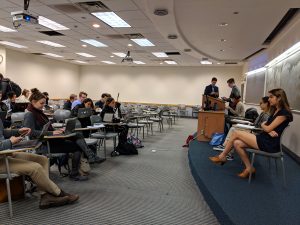The Swipe out Hunger Program, a student-organized campaign that compiles donated meal swipes to help combat food insecurity on campus, doubled its number of donated swipes this semester. The campaign collected 1,092 swipes, compared with 538 swipes last semester. The swipes will be accessible through the semester.
The campaign launched its first meal swipe donation drive last February through which students could access physical vouchers in various locations across campus, including the Center for Social Justice, Hoya Hub , Center for Student Engagement, and Georgetown Scholars Program. All of last semester’s vouchers were used.
This year, the donated swipes will be accessible through iPad banks across campus, where students can request up to 10 meal swipes per semester that will automatically upload to their GOCards.
Izzy Ortiz (MSB ’20) and Alandro Valdez (COL ’21) co-founded the campaign at Georgetown, as a chapter of the larger Swipe out Hunger nonprofit.
“I had a friend at UCLA, which is where it started, and she was involved in the club there,” Ortiz said. “An article in the Hoya came out at the same time talking about food insecurity on Georgetown’s campus, and so that’s how I got the idea.”
Ortiz said she received guidance from the nonprofit when she initially brought the idea to Georgetown.
“A liaison from [Swipe out Hunger] was directly assigned to me and she kind of walked me through the process about how to go about doing it with dining,” she added.
Ortiz and Valdez coordinated with Aramark, the third-party organization that coordinates campus dining, as well as the Auxiliary Business Services, the dining branch of the administration to launch the program.
“Last semester, it was a little bit more haphazard because we had less time to kind of ‘do’ the program and to set it all up, so it was a little ad hoc, word of mouth kind of thing,” Valdez said. “This year it was a little bit better, with you know more traditional facebook events, contact email to your clubs, getting Hoya Hub involved, contacting campus partners, it was a little more organized.”
The founders of the project report that students have been willing to donate, which helps explain the dramatic donation increase.
“It’s definitely not a lack of people in Georgetown’s community wanting to help,” she said. “It’s just getting the word out there, but also making sure that we’re addressing the aspect of food insecurity, and moving towards working away from the stigma that people don’t want to go to the food pantry or don’t want to use these meal swipes.”
Both Ortiz and Valdez noted the increasing awareness of food insecurity at colleges and universities nationwide. According to Valdez, this increased awareness was in part due to a study on Georgetown psychology students, which revealed that an alarming percentage of students reported having missed meals for three consecutive days.
“There was just a climate on campus at the time that people knew that the problem was an actual problem and there needed to be a solution,” Valdez said.
Ortiz spoke to the stark disparities between students on different meal plans, some of whom have excess swipes.
“I think it’s also just an issue, just that we have this resource in the community with students that have unlimited meal plans and then this direct dichotomy of students that are going hungry,” she said. “Everyone here wants to help.”
Ortiz and Valdez are confident that the program will continue to grow, with the combined support of the administration and student participants.
“I think there’s an appetite, even within the administration and Aramark representatives, to allow for upwards of 2,000-ish to be donated a semester, which is on par with a lot of other universities that have the program,” Valdez said.
Ortiz added that she is also confident that the program will continue to flourish at Georgetown. “I think it’ll just continue to grow from here.”





